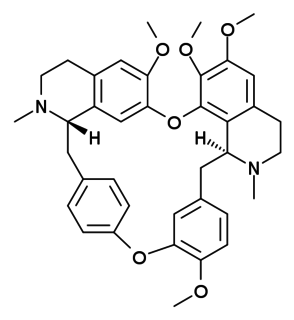
Hepatocyte growth factor (HGF) or scatter factor (SF) is a paracrine cellular growth, motility and morphogenic factor. It is secreted by mesenchymal cells and targets and acts primarily upon epithelial cells and endothelial cells, but also acts on haemopoietic progenitor cells and T cells. It has been shown to have a major role in embryonic organ development, specifically in myogenesis, in adult organ regeneration, and in wound healing.

Cell death-inducing DFFA-like effector b, also known as CIDEB, is a human gene.

Baicalein (5,6,7-trihydroxyflavone) is a flavone, a type of flavonoid, originally isolated from the roots of Scutellaria baicalensis and Scutellaria lateriflora. It is also reported in Oroxylum indicum and Thyme. It is the aglycone of baicalin. Baicalein is one of the active ingredients of Sho-Saiko-To, a Chinese herbal supplement believed to enhance liver health.

Tetrandrine, a bis-benzylisoquinoline alkaloid, is a calcium channel blocker. It has anti-inflammatory, immunologic and antiallergenic effects. It inhibits the degranulation of mast cells. It has a "quinidine-like" anti-arrhythmic effect. It has been isolated from Stephania tetrandra S Moore, and other Chinese and Japanese herbs. It has vasodilatory properties and can therefore reduce blood pressure. Tetrandrine may have potential use for the treatment of liver disease and liver cancer. Tetrandrine has potential therapeutic value to prevent excess scarring/fibrosis in conjunctiva following trabeculectomy or in patients with severe conjunctival inflammation. Tetrandrine has anti-inflammatory and anti-fibrogenic actions, which make tetrandrine and related compounds potentially useful in the treatment of lung silicosis, liver cirrhosis, and rheumatoid arthritis. Tetrandrine has also been shown to inhibit entry of Ebola virus into host cells in vitro and showed therapeutic efficacy against Ebola in preliminary studies on mice.

Taxifolin (5,7,3',4'-flavan-on-ol), also known as dihydroquercetin, belongs to the subclass flavanonols in the flavonoids, which in turn is a class of polyphenols.

Astilbin is a flavanonol, a type of flavonoid. Astilbin is the (2R-trans)-isomer; neoisoastilbin is the (2S-cis)-isomer and isoastilbin is the (2R-cis)-isomer.

Licochalcone A is a chalconoid, a type of natural phenol. It can be isolated from root of Glycyrrhiza glabra (liquorice) or Glycyrrhiza inflata. It shows antimalarial, anticancer, antibacterial and antiviral properties in vitro.

Kaempferol 7-O-glucoside is a flavonol glucoside. It can be found in Smilax china, and in the fern Asplenium rhizophyllum, and its hybrid descendants, as part of a complex with caffeic acid.

Smilax china is a climbing plant species in the genus Smilax. It is native to China, Korea, Taiwan, Japan, Philippines, Vietnam, Thailand, Myanmar, and Assam. Common names for the plant include China root.

Taiwanofungus camphoratus, also known as stout camphor fungus, is a species of fungus that is endemic to Taiwan, where it grows only on the endemic tree Cinnamomum kanehirae, causing a brown heart rot. Synonyms include Antrodia camphorata and Ganoderma camphoratum.
Streptomyces xishensis is a bacterium species from the genus of Streptomyces which has been isolated from marine sediments from the South China Sea near the Xisha Islands in China.
Erythrobacter luteus is a Gram-negative and aerobic bacteria from the genus of Erythrobacter which has been isolated from mangrove sediment from the Yunxiao mangrove National Nature Reserve in the Fujian Province in China.
Nocardiopsis xinjiangensis is a halophilic bacterium from the genus of Nocardiopsis which has been isolated from saline soil in the Xinjiang Province in China.
Phaeodactylibacter is a genus from the family of Saprospiraceae.
Prauserella is a Gram-positive, aerobic and non-motile genus from the family of Pseudonocardiaceae.
HuS-E/2 cells are immortalized primary human hepatocytes that were isolated from the discarded old liver tissue obtained from a 9-year-old male patient with primary hyperoxaluria who had undergone liver transplantation to receive a new liver. Hepatocytes were transduced with hTERT and HPV-E6E7 oncogenes. This immortalized hepatocyte cell line showed similar characteristics to primary hepatocytes, and was beneficial in the study of Hepatitis C and B viruses













